Booster Juce for your car
Hydrogen is very explosive and dangerous if not properly handled.
Warning!
If anything should happen we (and anyone affiliated with this site) are not in any way responsible for damages done to you, your vehicle, or any of your surroundings, as a result of use or misuse of these plans.
Warning!
If anything should happen we (and anyone affiliated with this site) are not in any way responsible for damages done to you, your vehicle, or any of your surroundings, as a result of use or misuse of these plans.
Hydrogen
Hydrogen is not new to internal combustion engines; it has been used in many parts of the world for many years. There are many different ways to build a hydrogen system. In doing so some systems may require different adjustments for different types of vehicles.
Basically all these systems are hydrogen on demand, which means that they produce only the amount of hydrogen that your engine uses. There is no need to carry great big tanks like the space shuttle. Also you don’t have to find a hydrogen station to refuel. There is no stored hydrogen on the vehicle while parked in your driveway. The hydrogen on demand system once filled with water will last hundreds of miles.
Basically all these systems are hydrogen on demand, which means that they produce only the amount of hydrogen that your engine uses. There is no need to carry great big tanks like the space shuttle. Also you don’t have to find a hydrogen station to refuel. There is no stored hydrogen on the vehicle while parked in your driveway. The hydrogen on demand system once filled with water will last hundreds of miles.
How it works
Two electrodes are placed in water, when electricity passes through the water it is broken down to hydrogen (2 parts) and oxygen (1 part). The hydrogen and oxygen are then sucked into the engine and burned as fuel. Hydrogen is one of the cleanest burning fuels known.
The bi product of burnt hydrogen is water, so no need to put catalytic converters on vehicles that burn straight hydrogen; whereas only about 30% of gasoline is completely burnt and the rest comes out of the exhaust as carbon monoxide and many other pollutants. That is why they put catalytic converters on their so called "modern fuel efficient engines" of today.
The bi product of burnt hydrogen is water, so no need to put catalytic converters on vehicles that burn straight hydrogen; whereas only about 30% of gasoline is completely burnt and the rest comes out of the exhaust as carbon monoxide and many other pollutants. That is why they put catalytic converters on their so called "modern fuel efficient engines" of today.
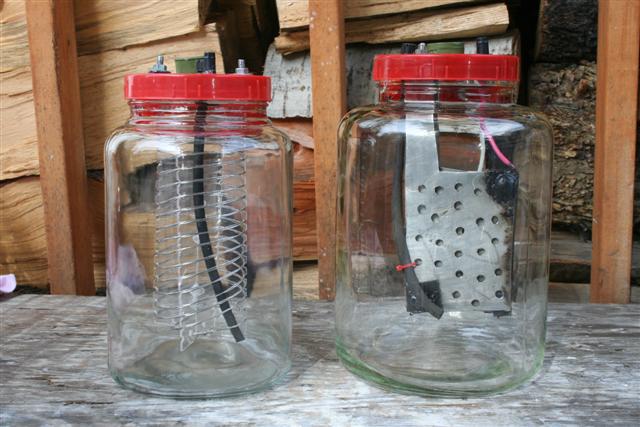
One has wire and the other has plates (all stainless steel)
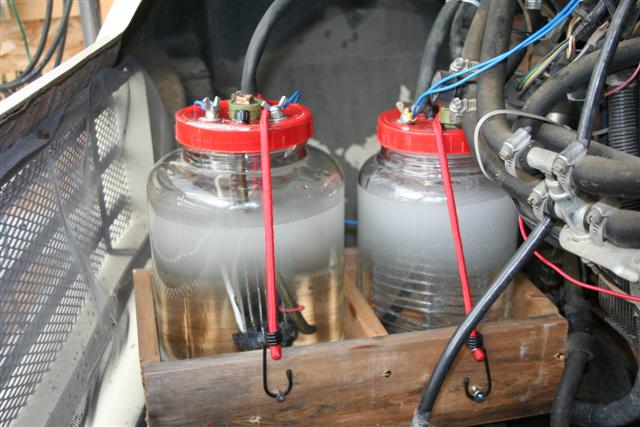
Running a test on 460 Ford
Hydrogen Cell V1
Here is a video on my first hydrogen cell
A rough sketch on how the hydrogen cell works
Not drawn to scale
Φ Use a jar with a sealed plastic lid so that the positive and negative are isolated.
Φ Stainless steel plates, other metals will corrode quickly, experiment with the number of plates and the distance between them. About a quarter of an inch works well, make sure they don’t touch. If using wire, use stainless steel welding wire. I twisted three wires together to get a little more displacement.
Φ Red is to positive black is to negative.
ΦGreen is a small adjustable valve to let air in, with a tube to the bottom, aquarium or drip irrigation valve works well, adjust so very small amount of air comes into the jar, two bubbles per second. This is optional.
Φ Purple is a tube that goes to the intake of the engine, depends on the size of the jar, about one quarter inch, use good quality rubber hose and keep away from high heat.
ΦBlue is a screw cap to fill with water.
Φ Stainless steel plates, other metals will corrode quickly, experiment with the number of plates and the distance between them. About a quarter of an inch works well, make sure they don’t touch. If using wire, use stainless steel welding wire. I twisted three wires together to get a little more displacement.
Φ Red is to positive black is to negative.
ΦGreen is a small adjustable valve to let air in, with a tube to the bottom, aquarium or drip irrigation valve works well, adjust so very small amount of air comes into the jar, two bubbles per second. This is optional.
Φ Purple is a tube that goes to the intake of the engine, depends on the size of the jar, about one quarter inch, use good quality rubber hose and keep away from high heat.
ΦBlue is a screw cap to fill with water.
Some tips to keep in mind
ΦUse distilled water, tap water doesn’t work as well because of the minerals and crap that’s in it.
ΦI use baking soda as a catalyst no more that one-teaspoon per jar. If you put too much your jar will overheat
ΦMake sure you have a fuse on the wire that energizes the system, no more than 30 amp. Use heavy wire # 10 or similar
ΦDo not use a switch to turn the unit on and off, hook it up to the ignition, or to the on position of the wiper motor, so it only works when the ignition is on the on position otherwise you could forget the unit is on and it will build up a bunch of hydrogen, and that could be HEAVY DANGER!!
ΦThe unit with the plates draws considerably more current than the ones with wire, therefore putting more strain on the alternator and wiring. One way to solve this is to hook two of them in series, and you will get more hydrogen using less amps.
ΦKeep all wires and lines away from the exhaust of the engine.
There are many censors on newer cars. When hydrogen is introduced into the air intake it enriches the air quality, therefore making the exhaust much cleaner. The engine censors are made to operate on “normal air”. As soon as the computer detects the different air quality it thinks it's running too lean and adjusts the fuel/air mixture, which will cause the engine to run improperly. There are many ways to correct this problem. Some people replace the censor with a dummy. Others build a circuit to bypass the censors. A quick check on the internet under "Electronic Fuel Injection Enhancer" will give you many solutions.
ΦUse distilled water, tap water doesn’t work as well because of the minerals and crap that’s in it.
ΦI use baking soda as a catalyst no more that one-teaspoon per jar. If you put too much your jar will overheat
ΦMake sure you have a fuse on the wire that energizes the system, no more than 30 amp. Use heavy wire # 10 or similar
ΦDo not use a switch to turn the unit on and off, hook it up to the ignition, or to the on position of the wiper motor, so it only works when the ignition is on the on position otherwise you could forget the unit is on and it will build up a bunch of hydrogen, and that could be HEAVY DANGER!!
ΦThe unit with the plates draws considerably more current than the ones with wire, therefore putting more strain on the alternator and wiring. One way to solve this is to hook two of them in series, and you will get more hydrogen using less amps.
ΦKeep all wires and lines away from the exhaust of the engine.
There are many censors on newer cars. When hydrogen is introduced into the air intake it enriches the air quality, therefore making the exhaust much cleaner. The engine censors are made to operate on “normal air”. As soon as the computer detects the different air quality it thinks it's running too lean and adjusts the fuel/air mixture, which will cause the engine to run improperly. There are many ways to correct this problem. Some people replace the censor with a dummy. Others build a circuit to bypass the censors. A quick check on the internet under "Electronic Fuel Injection Enhancer" will give you many solutions.
A 6-pack made from small jars, because of space.
Newer engines
We have a 1983 Olds with a 305 cu. in. engine. Before I installed this unit it ran about 18 to 20 miles per gallon. With this unit we get anywhere from 25 to 29 miles per gallon. The diagram below shows how I hooked the 6-pack up. Green to ground and red to on position of ignition (don't forget the fuse).
After driving the car with the Booster Juce installed, we noticed that the car performed better and ran a lot cleaner
After driving the car with the Booster Juce installed, we noticed that the car performed better and ran a lot cleaner
Hydrogen Cell V2
Red goes to the positive, black goes to the negative and green are neutral plates.
This arrangement seems to work a lot better. It takes a lot less amps and still produces a fair amount of hydrogen.
This arrangement seems to work a lot better. It takes a lot less amps and still produces a fair amount of hydrogen.
Hydrogen cell with neutral plates

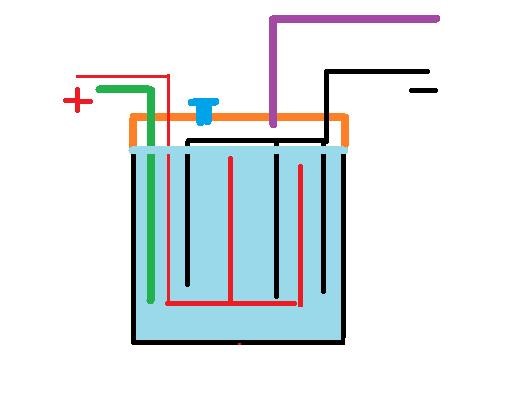
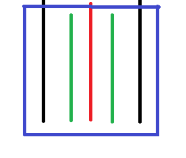
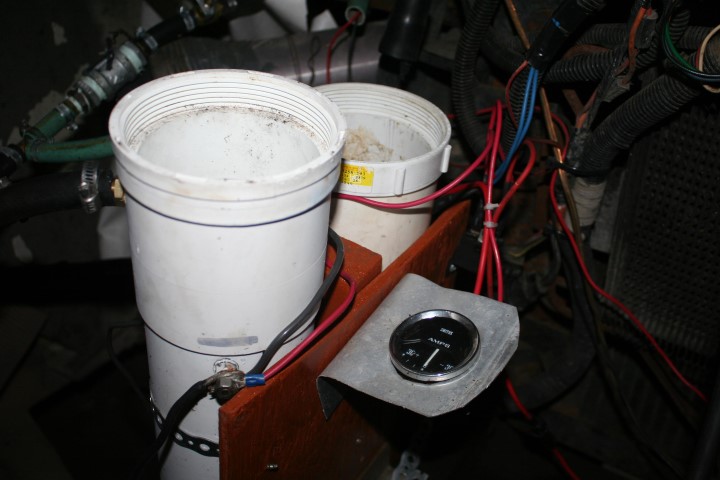
Our Vimeo Channel: The Goldseekers
Our U Tube Channel: TheGoldseekers





